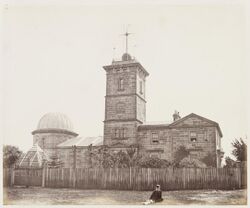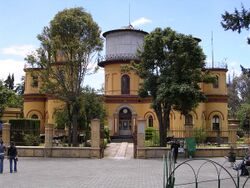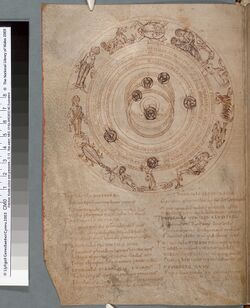Broken/Astronomy
Astronomy (from Greek: ἀστρονομία) is a natural science that studies celestial objects and phenomena. It applies mathematics, physics, and chemistry in an effort to explain the origin of those objects and phenomena and their evolution. Objects of interest include planets, moons, stars, nebulae, galaxies, and comets; the phenomena also includes supernova explosions, gamma ray bursts, quasars, blazars, pulsars, and cosmic microwave background radiation. More generally, all phenomena that originate outside Earth's atmosphere are within the purview of astronomy. A branch of astronomy called cosmology is the study of the Universe as a whole.[1]
Astronomy is one of the oldest of the natural sciences. The early civilizations in recorded history, such as the Babylonians, Greeks, Indians, Egyptians, Nubians, Iranians, Chinese, Maya, and many ancient indigenous peoples of the Americas, performed methodical observations of the night sky. Historically, astronomy has included disciplines as diverse as astrometry, celestial navigation, observational astronomy, and the making of calendars, but professional astronomy is now often considered to be synonymous with astrophysics.[2]
Professional astronomy is split into observational and theoretical branches. Observational astronomy is focused on acquiring data from observations of astronomical objects, which is then analyzed using basic principles of physics. Theoretical astronomy is oriented toward the development of computer or analytical models to describe astronomical objects and phenomena. The two fields complement each other, with theoretical astronomy seeking to explain observational results and observations being used to confirm theoretical results.
Astronomy is one of the few sciences in which amateurs still play an active role, especially in the discovery and observation of transient events. Amateur astronomers have made and contributed to many important astronomical discoveries, such as finding new comets.
Etymology
Astronomy (from the Greek ἀστρονομία from ἄστρον astron, "star" and -νομία -nomia from νόμος nomos, "law" or "culture") means "law of the stars" (or "culture of the stars" depending on the translation). Astronomy should not be confused with astrology, the belief system which claims that human affairs are correlated with the positions of celestial objects.[4] Although the two fields share a common origin, they are now entirely distinct.[5]
Use of terms "astronomy" and "astrophysics"
Generally, both of the terms "astronomy" and "astrophysics" may be used to refer to the same subject.[6][7][8] Based on strict dictionary definitions, "astronomy" refers to "the study of objects and matter outside the Earth's atmosphere and of their physical and chemical properties,"[9] while "astrophysics" refers to the branch of astronomy dealing with "the behavior, physical properties, and dynamic processes of celestial objects and phenomena."[10] In some cases, as in the introduction of the introductory textbook The Physical Universe by Frank Shu, "astronomy" may be used to describe the qualitative study of the subject, whereas "astrophysics" is used to describe the physics-oriented version of the subject.[11] However, since most modern astronomical research deals with subjects related to physics, modern astronomy could actually be called astrophysics.[6] Some fields, such as astrometry, are purely astronomy rather than also astrophysics. Various departments in which scientists carry out research on this subject may use "astronomy" and "astrophysics", partly depending on whether the department is historically affiliated with a physics department,[7] and many professional astronomers have physics rather than astronomy degrees.[8] Some titles of the leading scientific journals in this field include The Astronomical Journal, The Astrophysical Journal, and Astronomy and Astrophysics.
History
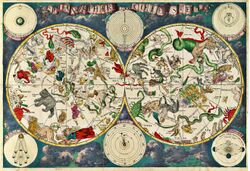
Ancient times
In early historic times, astronomy only consisted of the observation and predictions of the motions of objects visible to the naked eye. In some locations, early cultures assembled massive artifacts that possibly had some astronomical purpose. In addition to their ceremonial uses, these observatories could be employed to determine the seasons, an important factor in knowing when to plant crops and in understanding the length of the year.[12]
Before tools such as the telescope were invented, early study of the stars was conducted using the naked eye. As civilizations developed, most notably in Mesopotamia, Greece, Persia, India, China, Egypt, and Central America, astronomical observatories were assembled and ideas on the nature of the Universe began to develop. Most early astronomy consisted of mapping the positions of the stars and planets, a science now referred to as astrometry. From these observations, early ideas about the motions of the planets were formed, and the nature of the Sun, Moon and the Earth in the Universe were explored philosophically. The Earth was believed to be the center of the Universe with the Sun, the Moon and the stars rotating around it. This is known as the geocentric model of the Universe, or the Ptolemaic system, named after Ptolemy.[13]
A particularly important early development was the beginning of mathematical and scientific astronomy, which began among the Babylonians, who laid the foundations for the later astronomical traditions that developed in many other civilizations.[14] The Babylonians discovered that lunar eclipses recurred in a repeating cycle known as a saros.[15]
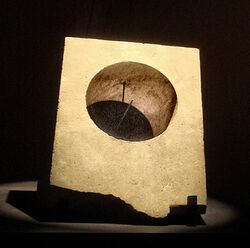
Following the Babylonians, significant advances in astronomy were made in ancient Greece and the Hellenistic world. Greek astronomy is characterized from the start by seeking a rational, physical explanation for celestial phenomena.[16] In the 3rd century BC, Aristarchus of Samos estimated the size and distance of the Moon and Sun, and he proposed a model of the Solar System where the Earth and planets rotated around the Sun, now called the heliocentric model.[17] In the 2nd century BC, Hipparchus discovered precession, calculated the size and distance of the Moon and invented the earliest known astronomical devices such as the astrolabe.[18] Hipparchus also created a comprehensive catalog of 1020 stars, and most of the constellations of the northern hemisphere derive from Greek astronomy.[19] The Antikythera mechanism (c. 150–80 BC) was an early analog computer designed to calculate the location of the Sun, Moon, and planets for a given date. Technological artifacts of similar complexity did not reappear until the 14th century, when mechanical astronomical clocks appeared in Europe.[20]
Middle Ages
Medieval Europe housed a number of important astronomers. Richard of Wallingford (1292–1336) made major contributions to astronomy and horology, including the invention of the first astronomical clock, the Rectangulus which allowed for the measurement of angles between planets and other astronomical bodies, as well as an equatorium called the Albion which could be used for astronomical calculations such as lunar, solar and planetary longitudes and could predict eclipses. Nicole Oresme (1320–1382) and Jean Buridan (1300–1361) first discussed evidence for the rotation of the Earth, furthermore, Buridan also developed the theory of impetus (predecessor of the modern scientific theory of inertia) which was able to show planets were capable of motion without the intervention of angels.[21] Georg von Peuerbach (1423–1461) and Regiomontanus (1436–1476) helped make astronomical progress instrumental to Copernicus's development of the heliocentric model decades later.
Astronomy flourished in the Islamic world and other parts of the world. This led to the emergence of the first astronomical observatories in the Muslim world by the early 9th century.[22][23][24] In 964, the Andromeda Galaxy, the largest galaxy in the Local Group, was described by the Persian Muslim astronomer Abd al-Rahman al-Sufi in his Book of Fixed Stars.[25] The SN 1006 supernova, the brightest apparent magnitude stellar event in recorded history, was observed by the Egyptian Arabic astronomer Ali ibn Ridwan and Chinese astronomers in 1006. Some of the prominent Islamic (mostly Persian and Arab) astronomers who made significant contributions to the science include Al-Battani, Thebit, Abd al-Rahman al-Sufi, Albumasar, Biruni, Abū Ishāq Ibrāhīm al-Zarqālī, Al-Birjandi, and the astronomers of the Maragheh and Samarkand observatories. Persian astrologer Albumasar's practical manuals for training astrologers profoundly influenced Muslim intellectual history and, through translations, that of western Europe and Byzantium.[26] His work was probably the single most important original source for the recovery of Aristotle for medieval European scholars prior to the middle of the 12th century.[27] The criticism of Ptolemy by Averroes directly influenced the Copernicus's heliocentrism.[28] Astronomers during that time introduced many Arabic names now used for individual stars.[29][30] It is also believed that the ruins at Great Zimbabwe and Timbuktu[31] may have housed astronomical observatories.[32] Europeans had previously believed that there had been no astronomical observation in sub-Saharan Africa during the pre-colonial Middle Ages, but modern discoveries show otherwise.[33][34][35][36]
For over six centuries (from the recovery of ancient learning during the late Middle Ages into the Enlightenment), the Roman Catholic Church gave more financial and social support to the study of astronomy than probably all other institutions. Among the Church's motives was finding the date for Easter.[37]
Scientific revolution

During the Renaissance, Nicolaus Copernicus proposed a heliocentric model of the solar system. His work was defended by Galileo Galilei and expanded upon by Johannes Kepler. Kepler was the first to devise a system that correctly described the details of the motion of the planets around the Sun. However, Kepler did not succeed in formulating a theory behind the laws he wrote down.[38] It was Isaac Newton, with his invention of celestial dynamics and his law of gravitation, who finally explained the motions of the planets. Newton also developed the reflecting telescope.[39]
Improvements in the size and quality of the telescope led to further discoveries. The English astronomer John Flamsteed catalogued over 3000 stars,[40] More extensive star catalogues were produced by Nicolas Louis de Lacaille. The astronomer William Herschel made a detailed catalog of nebulosity and clusters, and in 1781 discovered the planet Uranus, the first new planet found.[41] The distance to a star was announced in 1838 when the parallax of 61 Cygni was measured by Friedrich Bessel.[42]
During the 18–19th centuries, the study of the three-body problem by Leonhard Euler, Alexis Claude Clairaut, and Jean le Rond d'Alembert led to more accurate predictions about the motions of the Moon and planets. This work was further refined by Joseph-Louis Lagrange and Pierre Simon Laplace, allowing the masses of the planets and moons to be estimated from their perturbations.[43]
Significant advances in astronomy came about with the introduction of new technology, including the spectroscope and photography. Joseph von Fraunhofer discovered about 600 bands in the spectrum of the Sun in 1814–15, which, in 1859, Gustav Kirchhoff ascribed to the presence of different elements. Stars were proven to be similar to the Earth's own Sun, but with a wide range of temperatures, masses, and sizes.[29]
The existence of the Earth's galaxy, the Milky Way, as its own group of stars was only proved in the 20th century, along with the existence of "external" galaxies. The observed recession of those galaxies led to the discovery of the expansion of the Universe.[44] Theoretical astronomy led to speculations on the existence of objects such as black holes and neutron stars, which have been used to explain such observed phenomena as quasars, pulsars, blazars, and radio galaxies. Physical cosmology made huge advances during the 20th century. In the early 1900s the model of the Big Bang theory was formulated, heavily evidenced by cosmic microwave background radiation, Hubble's law, and the cosmological abundances of elements. Space telescopes have enabled measurements in parts of the electromagnetic spectrum normally blocked or blurred by the atmosphere.[citation needed] In February 2016, it was revealed that the LIGO project had detected evidence of gravitational waves in the previous September.[45][46]
Observational astronomy
The main source of information about celestial bodies and other objects is visible light, or more generally electromagnetic radiation.[47] Observational astronomy may be categorized according to the corresponding region of the electromagnetic spectrum on which the observations are made. Some parts of the spectrum can be observed from the Earth's surface, while other parts are only observable from either high altitudes or outside the Earth's atmosphere. Specific information on these subfields is given below.
Radio astronomy
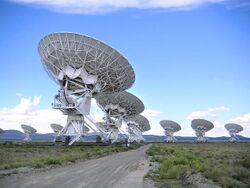
Radio astronomy uses radiation with wavelengths greater than approximately one millimeter, outside the visible range.[48] Radio astronomy is different from most other forms of observational astronomy in that the observed radio waves can be treated as waves rather than as discrete photons. Hence, it is relatively easier to measure both the amplitude and phase of radio waves, whereas this is not as easily done at shorter wavelengths.[48]
Although some radio waves are emitted directly by astronomical objects, a product of thermal emission, most of the radio emission that is observed is the result of synchrotron radiation, which is produced when electrons orbit magnetic fields.[48] Additionally, a number of spectral lines produced by interstellar gas, notably the hydrogen spectral line at 21 cm, are observable at radio wavelengths.[11][48]
A wide variety of other objects are observable at radio wavelengths, including supernovae, interstellar gas, pulsars, and active galactic nuclei.[11][48]
Infrared astronomy
Infrared astronomy is founded on the detection and analysis of infrared radiation, wavelengths longer than red light and outside the range of our vision. The infrared spectrum is useful for studying objects that are too cold to radiate visible light, such as planets, circumstellar disks or nebulae whose light is blocked by dust. The longer wavelengths of infrared can penetrate clouds of dust that block visible light, allowing the observation of young stars embedded in molecular clouds and the cores of galaxies. Observations from the Wide-field Infrared Survey Explorer (WISE) have been particularly effective at unveiling numerous Galactic protostars and their host star clusters.[50][51] With the exception of infrared wavelengths close to visible light, such radiation is heavily absorbed by the atmosphere, or masked, as the atmosphere itself produces significant infrared emission. Consequently, infrared observatories have to be located in high, dry places on Earth or in space.[52] Some molecules radiate strongly in the infrared. This allows the study of the chemistry of space; more specifically it can detect water in comets.[53]
Optical astronomy
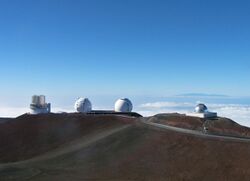
Historically, optical astronomy, also called visible light astronomy, is the oldest form of astronomy.[54] Images of observations were originally drawn by hand. In the late 19th century and most of the 20th century, images were made using photographic equipment. Modern images are made using digital detectors, particularly using charge-coupled devices (CCDs) and recorded on modern medium. Although visible light itself extends from approximately 4000 Å to 7000 Å (400 nm to 700 nm),[54] that same equipment can be used to observe some near-ultraviolet and near-infrared radiation.
Ultraviolet astronomy
References
- ↑ Unsöld, Albrecht; Baschek, Bodo (2001). Classical Astronomy and the Solar System – Introduction. pp. 1.
- ↑ Unsöld, Albrecht; Baschek, Bodo (2001). Classical Astronomy and the Solar System. pp. 6–9.
- ↑ http://oaq.epn.edu.ec/ Official Web Site of one of the oldest Observatories in South America, the Quito Astronomical Observatory
- ↑ Losev A., (2012), 'Astronomy' or 'astrology': a brief history of an apparent confusion, Journal of Astronomical History and Heritage, Vol. 15, No. 1, pp. 42–46 .
- ↑ Unsöld, Albrecht; Baschek, Bodo (2001). The New Cosmos: An Introduction to Astronomy and Astrophysics. Translated by Brewer, W.D.. Berlin, New York: Springer. ISBN 978-3-540-67877-9.
- ↑ 6.0 6.1 Scharringhausen, B.. "Curious About Astronomy: What is the difference between astronomy and astrophysics?". Archived from the original on 9 June 2007. https://web.archive.org/web/20070609102139/http://curious.astro.cornell.edu/question.php?number=30. Retrieved 17 November 2016.
- ↑ 7.0 7.1 Odenwald, Sten. "Archive of Astronomy Questions and Answers: What is the difference between astronomy and astrophysics?". The Astronomy Cafe. Archived from the original on 8 July 2007. https://web.archive.org/web/20070708092148/http://www.astronomycafe.net/qadir/q449.html. Retrieved 20 June 2007.
- ↑ 8.0 8.1 "Penn State Erie-School of Science-Astronomy and Astrophysics". Archived from the original on 1 November 2007. https://web.archive.org/web/20071101100832/http://www.erie.psu.edu/academic/science/degrees/astronomy/astrophysics.htm. Retrieved 20 June 2007.
- ↑ "Merriam-Webster Online". Results for "astronomy". Archived from the original on 17 June 2007. https://web.archive.org/web/20070617131203/http://www.m-w.com/dictionary/astronomy. Retrieved 20 June 2007.
- ↑ "Merriam-Webster Online". Results for "astrophysics". http://www.m-w.com/dictionary/astrophysics. Retrieved 20 June 2007.
- ↑ 11.0 11.1 11.2 Shu, F.H. (1983). The Physical Universe. Mill Valley, California: University Science Books. ISBN 978-0-935702-05-7.
- ↑ Forbes, 1909
- ↑ DeWitt, Richard (2010). "The Ptolemaic System". Worldviews: An Introduction to the History and Philosophy of Science. Chichester, England: Wiley. p. 113. ISBN 978-1-4051-9563-8.
- ↑ Aaboe, A. (1974). "Scientific Astronomy in Antiquity". Philosophical Transactions of the Royal Society 276 (1257): 21–42. doi:10.1098/rsta.1974.0007. Bibcode: 1974RSPTA.276...21A.
- ↑ "Eclipses and the Saros". NASA. Archived from the original on 30 October 2007. https://web.archive.org/web/20071030225501/http://sunearth.gsfc.nasa.gov/eclipse/SEsaros/SEsaros.html. Retrieved 28 October 2007.
- ↑ Krafft, Fritz (2009). "Astronomy". in Cancik, Hubert; Schneider, Helmuth. Brill's New Pauly.
- ↑ Berrgren, J.L.; Nathan Sidoli (May 2007). "Aristarchus's On the Sizes and Distances of the Sun and the Moon: Greek and Arabic Texts". Archive for History of Exact Sciences 61 (3): 213–54. doi:10.1007/s00407-006-0118-4.
- ↑ "Hipparchus of Rhodes". School of Mathematics and Statistics, University of St Andrews, Scotland. Archived from the original on 23 October 2007. https://web.archive.org/web/20071023062202/http://www-groups.dcs.st-and.ac.uk/~history/Biographies/Hipparchus.html. Retrieved 28 October 2007.
- ↑ Thurston, H. (1996). Early Astronomy. Springer Science & Business Media. p. 2. ISBN 978-0-387-94822-5. https://books.google.com/books?id=rNpHjqxQQ9oC&pg=PA2.
- ↑ Marchant, Jo (2006). "In search of lost time". Nature 444 (7119): 534–38. doi:10.1038/444534a. PMID 17136067. Bibcode: 2006Natur.444..534M.
- ↑ Hannam, James. God's philosophers: how the medieval world laid the foundations of modern science. Icon Books Ltd, 2009, 180
- ↑ Kennedy, Edward S. (1962). "Review: The Observatory in Islam and Its Place in the General History of the Observatory by Aydin Sayili". Isis 53 (2): 237–39. doi:10.1086/349558.
- ↑ Micheau, Françoise. Rashed, Roshdi; Morelon, Régis. eds. "The Scientific Institutions in the Medieval Near East". Encyclopedia of the History of Arabic Science 3: 992–93.
- ↑ Nas, Peter J (1993). Urban Symbolism. Brill Academic Publishers. p. 350. ISBN 978-90-04-09855-8.
- ↑ Kepple, George Robert; Glen W. Sanner (1998). The Night Sky Observer's Guide. 1. Willmann-Bell, Inc.. p. 18. ISBN 978-0-943396-58-3.
- ↑ Pingree, D.. "ABŪ MAʿŠAR – Encyclopaedia Iranica" (in en). Encyclopedia Iranica. http://www.iranicaonline.org/articles/abu-masar-jafar-b. Retrieved 11 February 2017.
- ↑ Richard Lemay, Abu Ma'shar and Latin Aristotelianism in the Twelfth Century, The Recovery of Aristotle's Natural Philosophy through Iranian Astrology, 1962.
- ↑ Freely, John (30 March 2015). Light from the East: How the Science of Medieval Islam Helped to Shape the Western World. I.B.Tauris. p. 179. ISBN 978-1-78453-138-6.
- ↑ 29.0 29.1 Berry, Arthur (1961). A Short History of Astronomy From Earliest Times Through the 19th Century. New York: Dover Publications, Inc.. ISBN 978-0-486-20210-5.
- ↑ Hoskin, Michael, ed (1999). The Cambridge Concise History of Astronomy. Cambridge University Press. ISBN 978-0-521-57600-0.
- ↑ McKissack, Pat; McKissack, Frederick (1995). The royal kingdoms of Ghana, Mali, and Songhay: life in medieval Africa. H. Holt. ISBN 978-0-8050-4259-7. https://books.google.com/?id=Pk-bZMS_KdUC&pg=PA103&lpg=PA103.
- ↑ Clark, Stuart; Carrington, Damian (2002). "Eclipse brings claim of medieval African observatory". New Scientist. https://www.newscientist.com/article/dn3137-eclipse-brings-claim-of-medieval-african-observatory.html. Retrieved 3 February 2010.
- ↑ "Cosmic Africa explores Africa's astronomy". Science in Africa. Archived from the original on 3 December 2003. https://web.archive.org/web/20031203055223/http://www.scienceinafrica.co.za/2003/november/cosmic.htm. Retrieved 3 February 2002.
- ↑ Holbrook, Jarita C.; Medupe, R. Thebe; Urama, Johnson O. (2008). African Cultural Astronomy. Springer. ISBN 978-1-4020-6638-2. https://books.google.com/?id=4DJpDW6IAukC&pg=PA180&lpg=PA180.
- ↑ "Africans studied astronomy in medieval times". The Royal Society. 30 January 2006. Archived from the original on 9 June 2008. https://web.archive.org/web/20080609112829/http://royalsociety.org/news.asp?year=&id=4117. Retrieved 3 February 2010.
- ↑ Stenger, Richard "Star sheds light on African 'Stonehenge'". CNN. 5 December 2002. Archived from the original on 12 May 2011. https://web.archive.org/web/20110512162930/http://articles.cnn.com/2002-12-05/tech/zimbabwe.observatory_1_supernova-forecast-eclipses-star?_s=PM%3ATECH.. CNN. 5 December 2002. Retrieved on 30 December 2011.
- ↑ J.L. Heilbron, The Sun in the Church: Cathedrals as Solar Observatories (1999) p.3
- ↑ Forbes, 1909, pp. 49–58
- ↑ Forbes, 1909, pp. 58–64
- ↑ Chambers, Robert (1864) Chambers Book of Days
- ↑ Forbes, 1909, pp. 79–81
- ↑ Forbes, 1909, pp. 147–50
- ↑ Forbes, 1909, pp. 74–76
- ↑ Belkora, Leila (2003). Minding the heavens: the story of our discovery of the Milky Way. CRC Press. pp. 1–14. ISBN 978-0-7503-0730-7. https://books.google.com/?id=qBM-wez94WwC&printsec=frontcover.
- ↑ Castelvecchi, Davide; Witze, Witze (11 February 2016). "Einstein's gravitational waves found at last". Nature News. doi:10.1038/nature.2016.19361. http://www.nature.com/news/einstein-s-gravitational-waves-found-at-last-1.19361. Retrieved 11 February 2016.
- ↑ B.P. Abbott (LIGO Scientific Collaboration and Virgo Collaboration) (2016). "Observation of Gravitational Waves from a Binary Black Hole Merger". Physical Review Letters 116 (6): 061102. doi:10.1103/PhysRevLett.116.061102. PMID 26918975. Bibcode: 2016PhRvL.116f1102A.
- ↑ "Electromagnetic Spectrum". NASA. Archived from the original on 5 September 2006. https://web.archive.org/web/20060905131651/http://imagine.gsfc.nasa.gov/docs/science/know_l1/emspectrum.html. Retrieved 17 November 2016.
- ↑ 48.0 48.1 48.2 48.3 48.4 Cox, A.N., ed (2000). Allen's Astrophysical Quantities. New York: Springer-Verlag. p. 124. ISBN 978-0-387-98746-0. https://books.google.com/?id=w8PK2XFLLH8C&pg=PA124.
- ↑ "In Search of Space". Picture of the Week. European Southern Observatory. http://www.eso.org/public/images/potw1431a/. Retrieved 5 August 2014.
- ↑ "Wide-field Infrared Survey Explorer Mission". NASA University of California, Berkeley. 30 September 2014. http://wise.ssl.berkeley.edu/.
- ↑ Majaess, D. (2013). Discovering protostars and their host clusters via WISE, ApSS, 344, 1 (VizieR catalog)
- ↑ Staff (11 September 2003). "Why infrared astronomy is a hot topic". ESA. http://www.esa.int/esaCP/SEMX9PZO4HD_FeatureWeek_0.html. Retrieved 11 August 2008.
- ↑ "Infrared Spectroscopy – An Overview". NASA California Institute of Technology. Archived from the original on 5 October 2008. https://web.archive.org/web/20081005031543/http://www.ipac.caltech.edu/Outreach/Edu/Spectra/irspec.html. Retrieved 11 August 2008.
- ↑ 54.0 54.1 Moore, P. (1997). Philip's Atlas of the Universe. Great Britain: George Philis Limited. ISBN 978-0-540-07465-5.
Bibliography
- Forbes, George (1909). History of Astronomy. London: Plain Label Books. ISBN 978-1-60303-159-2. http://www.gutenberg.org/ebooks/8172.
- Harpaz, Amos (1994). Stellar Evolution. A K Peters, Ltd. ISBN 978-1-56881-012-6. https://books.google.com/?id=kd4VEZv8oo0C&dq.
- Unsöld, A.; Baschek, B. (2001). The New Cosmos: An Introduction to Astronomy and Astrophysics. Springer. ISBN 978-3-540-67877-9.
External links
- Astronomy (Original source)
- NASA/IPAC Extragalactic Database (NED) (NED-Distances)
- International Year of Astronomy 2009 IYA2009 Main website
- Cosmic Journey: A History of Scientific Cosmology from the American Institute of Physics
- Southern Hemisphere Astronomy
- Celestia Motherlode Educational site for Astronomical journeys through space
- Kroto, Harry, Astrophysical Chemistry Lecture Series.
- Core books and Core journals in Astronomy, from the Smithsonian/NASA Astrophysics Data System
- A Journey with Fred Hoyle by Wickramasinghe, Chandra.
- Astronomy books from the History of Science Collection at Linda Hall Library
